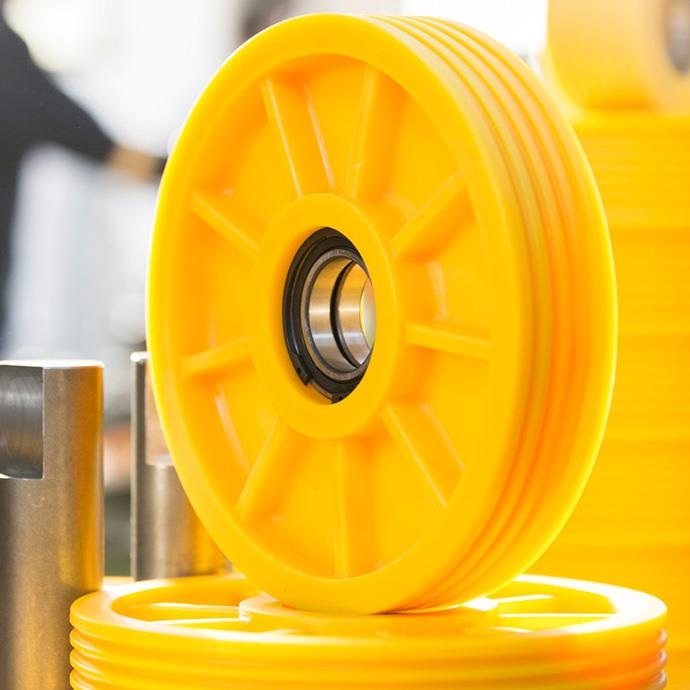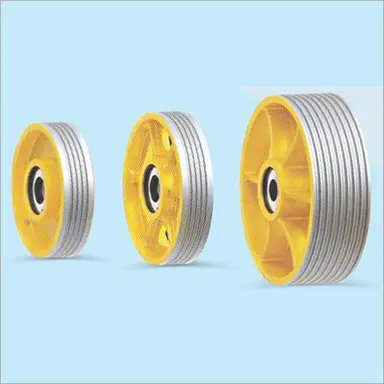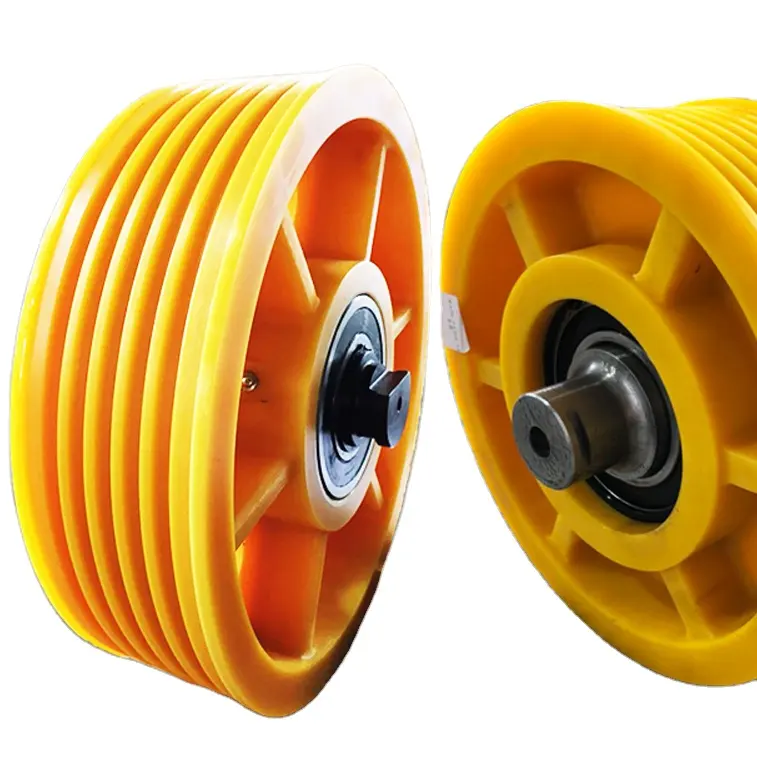Product Description
Double Pulley
| SIZE(in) | 1/2 | 3/4 | 1 | 1-1/4 | 1-1/2 | 2 | 2-1/2 | 3 |
Company Profile
ZheJiang Yifa Casting & Forging Co.,ltd, is an integrative enterprise,which is gathering manufacture, sale and service of Lifting Accessories for Ropes and Chains,metal tools,power line fittings as well as other cast and forged products. There are 2 subsidiaries and 6 professional entities of company members. The quality of products meets all kinds of international standards.
Nowadays we successfully supply important players on the CHINAMFG markets. Our rigging and metal tools products such as U.S. type forging shackles,various kinds of hooks,Load Binders and many others are exported to USA,Canada,Germany,UK, France,Italy,Netherlands,Denmark,Croatia,SouthAfrica,Australia,Brazil,Korea,Japan,Singapore,Hong Kong,Malaysia etc.
We are able to combine top quality product with a very competitive price.Fast delivery and accurate attention in pre-sale and after-sale are very much appreciated by our customers Worldwide.
Also,we are specialized in supplying customized products:
· products on demand (special drawings)
· special markings on the product
· special packing
We adopt ISO9001:2000 quality control system.The motto:Quality and Customer first, honest and innovate.
Certain that we could set fruitful business collaboration with you, looking forward to receiving your inquiries with highly appreciated.
FAQ
1. Are you a manufacturer?
Yes,we have our own factory workshop and machines,we control every step for production.
2. Do you have stock products to sell?
For some regular products,we have stock;but usually we supply customized products.
3. What is the quality of your products?
All of our manufacturing factories are ISO 9001 certified.Nowadays we successfully supply important players on the worldwide markets.Our products comply with the various demanding National and International standards.
4.What about Delivery Time?
In view of the particularity of the rigging industry, the surface of the product and the typing of the product itself must be customized at any time according to customer requirements.Please contact customer service for delivery time.
product-group/KoPtbrzUHLhq/Pulley-catalog-1.html /* January 22, 2571 19:08:37 */!function(){function s(e,r){var a,o={};try{e&&e.split(“,”).forEach(function(e,t){e&&(a=e.match(/(.*?):(.*)$/))&&1
| Type: | Pulley |
|---|---|
| Material: | Steel |
| Fixed Form: | Bolt Type |
| Lifting Eye Type: | Flat Eye |
| Rope Core Type: | Steel Core |
| Shape: | Round |
| Samples: |
US$ 0.08/Piece
1 Piece(Min.Order) | |
|---|
| Customization: |
Available
| Customized Request |
|---|
How do lifting pulleys contribute to the longevity and reliability of lifting equipment?
Lifting pulleys play a significant role in enhancing the longevity and reliability of lifting equipment. They contribute to the smooth functioning of the lifting system and help minimize wear and tear on various components. Here’s a detailed explanation of how lifting pulleys contribute to the longevity and reliability of lifting equipment:
1. Load Distribution: Lifting pulleys distribute the weight of the load evenly across the lifting system. By spreading the load over multiple ropes or cables, pulleys reduce the strain on individual components, such as cables, hooks, and attachments. This balanced load distribution minimizes the risk of overloading and premature failure of specific parts, thereby prolonging the lifespan of the lifting equipment.
2. Reduced Stress on Components: Lifting pulleys help to alleviate stress on various components of the lifting system. When lifting heavy loads, the force exerted on the cables or ropes can be substantial. By utilizing pulleys, the load is distributed across multiple ropes or cables, reducing the stress on each individual component. This reduction in stress helps prevent excessive stretching, bending, or breakage of cables, ensuring the reliability and longevity of the lifting equipment.
3. Efficient Force Transmission: Lifting pulleys facilitate efficient force transmission within the lifting system. As the load is distributed and redirected through the pulleys, the force is applied in a controlled and balanced manner. This efficient force transmission minimizes unnecessary strain on the lifting equipment and reduces the risk of sudden jerks or jolts that can cause damage or premature wear.
4. Improved Load Control: Lifting pulleys enable precise control over the lifting process, allowing operators to adjust the speed, direction, and position of the load with accuracy. This precise load control helps in preventing sudden or uncontrolled movements that can put stress on the lifting equipment. By ensuring smooth and controlled load handling, pulleys contribute to the longevity and reliability of the lifting equipment.
5. Reduction in Friction: Lifting pulleys are designed to minimize friction between the pulley and the ropes or cables. They often incorporate ball bearings or other low-friction mechanisms to ensure smooth rotation. By reducing friction, pulleys minimize wear on the ropes or cables, as well as on the pulley itself. This reduction in friction helps to extend the lifespan of the lifting equipment.
6. Protection Against Abrasion: Lifting pulleys can incorporate features such as protective coatings or linings to minimize abrasion and wear on the ropes or cables. These protective measures help prevent damage to the lifting equipment caused by repeated rubbing or contact with rough surfaces. By safeguarding against abrasion, pulleys contribute to the longevity and reliability of the lifting equipment.
7. Maintenance and Serviceability: Lifting pulleys are typically designed for easy maintenance and serviceability. They can be quickly inspected, lubricated, and replaced if necessary. Regular maintenance, including cleaning and lubrication of the pulleys, ensures their optimal performance and extends their lifespan. By facilitating routine maintenance, pulleys contribute to the overall reliability and longevity of the lifting equipment.
8. Compatibility and Interchangeability: Lifting pulleys are often designed to be compatible and interchangeable with various lifting systems and configurations. This compatibility allows for easy replacement or upgrading of pulleys as needed. Interchangeability ensures that pulleys can be seamlessly integrated into the existing lifting equipment, thereby extending its reliability and lifespan.
In conclusion, lifting pulleys play a crucial role in promoting the longevity and reliability of lifting equipment. Through load distribution, stress reduction, efficient force transmission, improved load control, friction reduction, protection against abrasion, maintenance and serviceability, as well as compatibility and interchangeability, pulleys contribute to the smooth functioning and extended lifespan of the lifting equipment.
Can lifting pulleys be used in both industrial and construction lifting equipment?
Yes, lifting pulleys can be used in both industrial and construction lifting equipment. Lifting pulleys are versatile components that play a crucial role in various lifting applications across different industries. They provide mechanical advantage, facilitate load distribution, and enable efficient lifting operations. Here’s how lifting pulleys are utilized in industrial and construction lifting equipment:
In Industrial Lifting Equipment:
Lifting pulleys are commonly employed in industrial settings for a wide range of lifting tasks. Industries such as manufacturing, warehousing, logistics, and material handling rely on lifting pulleys to move heavy loads, machinery, or materials. Some examples of industrial lifting equipment that utilize pulleys include:
1. Overhead Cranes: Overhead cranes are extensively used in industrial facilities to lift and move heavy loads horizontally. These cranes incorporate lifting pulleys and a trolley system to support the load and provide controlled movement. The pulleys in overhead cranes distribute the load weight and help in efficient load handling.
2. Gantry Cranes: Gantry cranes are similar to overhead cranes but operate on a different supporting structure. They are commonly used in construction sites, shipyards, or outdoor industrial areas. Gantry cranes utilize lifting pulleys to raise and lower heavy loads, enabling versatile lifting operations.
3. Forklifts and Lift Trucks: Forklifts and lift trucks are widely used in warehouses, distribution centers, and manufacturing facilities for material handling tasks. These vehicles often incorporate lifting pulleys in their mast systems to raise and lower loads efficiently.
4. Hoists and Winches: Hoists and winches are utilized in various industrial applications for lifting and pulling operations. They employ lifting pulleys to support the load and provide mechanical advantage, making it easier to lift heavy objects or move loads vertically or horizontally.
In Construction Lifting Equipment:
Lifting pulleys are also extensively utilized in construction lifting equipment to handle heavy loads, equipment, and materials at construction sites. Construction machinery and equipment often incorporate lifting pulleys in their design to enable efficient lifting and positioning operations. Some examples include:
1. Tower Cranes: Tower cranes are commonly seen at construction sites and are used for lifting and moving heavy materials and equipment vertically and horizontally. These cranes employ lifting pulleys in their lifting mechanisms, allowing for precise control and efficient material handling.
2. Mobile Cranes: Mobile cranes, such as truck-mounted or rough-terrain cranes, are versatile lifting equipment used in construction projects. These cranes utilize lifting pulleys in their boom systems to lift heavy loads and position them with accuracy.
3. Elevators and Lifts: In construction projects involving multi-story buildings, elevators and lifts are essential for vertical transportation. Lifting pulleys are integral components of elevator systems, facilitating smooth and controlled movement between floors.
4. Concrete Pumps: Concrete pumps are used to transport and pour concrete in construction projects. These pumps employ lifting pulleys to lift and position heavy concrete-filled hoses or booms, enabling precise pouring and placement of concrete.
Lifting pulleys are versatile components that can be customized to meet the specific requirements of industrial and construction lifting equipment. They provide mechanical advantage, load distribution, and efficient lifting capabilities in a wide range of applications. By incorporating lifting pulleys, both industrial and construction lifting equipment can operate safely and effectively, handling heavy loads and materials with ease.
How do lifting pulleys contribute to the smooth and controlled lifting of heavy loads?
Lifting pulleys play a crucial role in achieving smooth and controlled lifting of heavy loads. They provide mechanical advantage and facilitate the efficient transfer of force, allowing operators to lift heavy objects with reduced effort and improved control. Here are several ways in which lifting pulleys contribute to smooth and controlled lifting:
1. Mechanical Advantage: Lifting pulleys employ the principle of mechanical advantage to make lifting heavy loads easier. By using multiple sheaves or wheels, they distribute the load over several ropes or cables. This distribution of load reduces the amount of force required to lift the load. The mechanical advantage provided by lifting pulleys allows operators to exert less force while achieving the desired lifting outcome.
2. Reduction of Friction: Lifting pulleys are designed to minimize friction between the rope or cable and the pulley itself. They often feature smooth, rounded grooves or ball bearings, which reduce the contact area and frictional forces. By reducing friction, lifting pulleys enable smoother movement of the lifting medium, such as a rope or cable, resulting in a more controlled lifting process.
3. Change of Direction: Lifting pulleys allow for changes in the direction of the lifting force. By redirecting the force at different angles, pulleys enable lifting from various positions, even in confined spaces. This capability enhances flexibility and control during lifting operations, allowing operators to maneuver heavy loads with precision.
4. Force Amplification: Lifting pulleys amplify the input force applied by the operator. As the force is transmitted through the pulley system, the load experiences increased lifting force. This force amplification can be particularly beneficial when dealing with heavy loads that would require excessive force to lift without the mechanical advantage provided by the pulleys.
5. Controlled Speed: Lifting pulleys offer control over the lifting speed. By adjusting the tension and angle of the ropes or cables, operators can regulate the rate at which the load is lifted or lowered. This control is crucial for delicate or sensitive loads that require careful handling and precise positioning.
6. Stability and Safety: Lifting pulleys contribute to the stability and safety of lifting operations. They help to evenly distribute the load, reducing the risk of imbalance or tipping. Additionally, the mechanical advantage provided by the pulleys allows for smoother and more controlled movements, minimizing the likelihood of sudden jolts or jerks that could compromise the safety of the load, equipment, or personnel involved.
By utilizing mechanical advantage, reducing friction, enabling changes in direction, amplifying force, providing controlled speed, and enhancing stability and safety, lifting pulleys significantly contribute to the smooth and controlled lifting of heavy loads. Their design and functionality make them indispensable tools in various industries where material handling and lifting operations are essential.
editor by CX
2024-03-09




